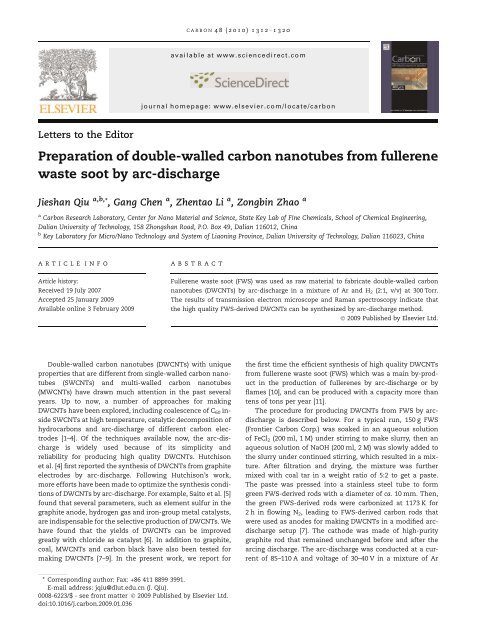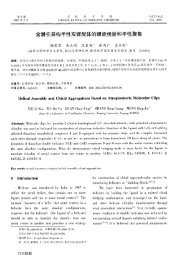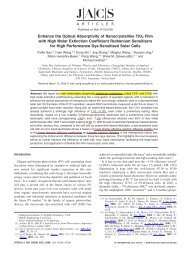Preparation of double-walled carbon nanotubes from fullerene ...
Preparation of double-walled carbon nanotubes from fullerene ...
Preparation of double-walled carbon nanotubes from fullerene ...
Create successful ePaper yourself
Turn your PDF publications into a flip-book with our unique Google optimized e-Paper software.
CARBON 48 (2010) 1312– 1320<br />
available at www.sciencedirect.com<br />
journal homepage: www.elsevier.com/locate/<strong>carbon</strong><br />
Letters to the Editor<br />
<strong>Preparation</strong> <strong>of</strong> <strong>double</strong>-<strong>walled</strong> <strong>carbon</strong> <strong>nanotubes</strong> <strong>from</strong> <strong>fullerene</strong><br />
waste soot by arc-discharge<br />
Jieshan Qiu a,b, *, Gang Chen a , Zhentao Li a , Zongbin Zhao a<br />
a Carbon Research Laboratory, Center for Nano Material and Science, State Key Lab <strong>of</strong> Fine Chemicals, School <strong>of</strong> Chemical Engineering,<br />
Dalian University <strong>of</strong> Technology, 158 Zhongshan Road, P.O. Box 49, Dalian 116012, China<br />
b Key Laboratory for Micro/Nano Technology and System <strong>of</strong> Liaoning Province, Dalian University <strong>of</strong> Technology, Dalian 116023, China<br />
ARTICLE<br />
INFO<br />
ABSTRACT<br />
Article history:<br />
Received 19 July 2007<br />
Accepted 25 January 2009<br />
Available online 3 February 2009<br />
Fullerene waste soot (FWS) was used as raw material to fabricate <strong>double</strong>-<strong>walled</strong> <strong>carbon</strong><br />
<strong>nanotubes</strong> (DWCNTs) by arc-discharge in a mixture <strong>of</strong> Ar and H 2 (2:1, v/v) at 300 Torr.<br />
The results <strong>of</strong> transmission electron microscope and Raman spectroscopy indicate that<br />
the high quality FWS-derived DWCNTs can be synthesized by arc-discharge method.<br />
Ó 2009 Published by Elsevier Ltd.<br />
Double-<strong>walled</strong> <strong>carbon</strong> <strong>nanotubes</strong> (DWCNTs) with unique<br />
properties that are different <strong>from</strong> single-<strong>walled</strong> <strong>carbon</strong> <strong>nanotubes</strong><br />
(SWCNTs) and multi-<strong>walled</strong> <strong>carbon</strong> <strong>nanotubes</strong><br />
(MWCNTs) have drawn much attention in the past several<br />
years. Up to now, a number <strong>of</strong> approaches for making<br />
DWCNTs have been explored, including coalescence <strong>of</strong> C 60 inside<br />
SWCNTs at high temperature, catalytic decomposition <strong>of</strong><br />
hydro<strong>carbon</strong>s and arc-discharge <strong>of</strong> different <strong>carbon</strong> electrodes<br />
[1–4]. Of the techniques available now, the arc-discharge<br />
is widely used because <strong>of</strong> its simplicity and<br />
reliability for producing high quality DWCNTs. Hutchison<br />
et al. [4] first reported the synthesis <strong>of</strong> DWCNTs <strong>from</strong> graphite<br />
electrodes by arc-discharge. Following Hutchison’s work,<br />
more efforts have been made to optimize the synthesis conditions<br />
<strong>of</strong> DWCNTs by arc-discharge. For example, Saito et al. [5]<br />
found that several parameters, such as element sulfur in the<br />
graphite anode, hydrogen gas and iron-group metal catalysts,<br />
are indispensable for the selective production <strong>of</strong> DWCNTs. We<br />
have found that the yields <strong>of</strong> DWCNTs can be improved<br />
greatly with chloride as catalyst [6]. In addition to graphite,<br />
coal, MWCNTs and <strong>carbon</strong> black have also been tested for<br />
making DWCNTs [7–9]. In the present work, we report for<br />
the first time the efficient synthesis <strong>of</strong> high quality DWCNTs<br />
<strong>from</strong> <strong>fullerene</strong> waste soot (FWS) which was a main by-product<br />
in the production <strong>of</strong> <strong>fullerene</strong>s by arc-discharge or by<br />
flames [10], and can be produced with a capacity more than<br />
tens <strong>of</strong> tons per year [11].<br />
The procedure for producing DWCNTs <strong>from</strong> FWS by arcdischarge<br />
is described below. For a typical run, 150 g FWS<br />
(Frontier Carbon Corp.) was soaked in an aqueous solution<br />
<strong>of</strong> FeCl 2 (200 ml, 1 M) under stirring to make slurry, then an<br />
aqueous solution <strong>of</strong> NaOH (200 ml, 2 M) was slowly added to<br />
the slurry under continued stirring, which resulted in a mixture.<br />
After filtration and drying, the mixture was further<br />
mixed with coal tar in a weight ratio <strong>of</strong> 5:2 to get a paste.<br />
The paste was pressed into a stainless steel tube to form<br />
green FWS-derived rods with a diameter <strong>of</strong> ca. 10 mm. Then,<br />
the green FWS-derived rods were <strong>carbon</strong>ized at 1173 K for<br />
2 h in flowing N 2 , leading to FWS-derived <strong>carbon</strong> rods that<br />
were used as anodes for making DWCNTs in a modified arcdischarge<br />
setup [7]. The cathode was made <strong>of</strong> high-purity<br />
graphite rod that remained unchanged before and after the<br />
arcing discharge. The arc-discharge was conducted at a current<br />
<strong>of</strong> 85–110 A and voltage <strong>of</strong> 30–40 V in a mixture <strong>of</strong> Ar<br />
* Corresponding author: Fax: +86 411 8899 3991.<br />
E-mail address: jqiu@dlut.edu.cn (J. Qiu).<br />
0008-6223/$ - see front matter Ó 2009 Published by Elsevier Ltd.<br />
doi:10.1016/j.<strong>carbon</strong>.2009.01.036
CARBON 48 (2010) 1312– 1320 1313<br />
and H 2 (2:1, v/v) at 300 Torr, and the gap between the electrodes<br />
was kept at ca. 2 mm during the arcing discharge. For<br />
each run, when FWS-derived anode with length <strong>of</strong> 3–4 cm<br />
was consumed, about 100–150 mg <strong>of</strong> DWCNTs film-like sticky<br />
deposite on the wire cage can be obtained.<br />
The as-obtained DWCNTs were examined using scanning<br />
electron microscope (SEM, JSM-6301F), transmission electron<br />
microscopy (TEM and HRTEM, Philips Tecnai G 2 20) and Raman<br />
spectroscopy (JY LabRam HR800 at 632.8 nm).<br />
The typical X-ray diffraction (XRD, Rigaku D/MAX 2400, Cu<br />
Ka, 40 kV and 100 mA) pr<strong>of</strong>ile <strong>of</strong> FWS-derived anode is shown<br />
in Fig. 1. The catalyst in the anode is Fe nanoparticles with<br />
diameters <strong>of</strong> ca. 40 nm that is estimated by Scherrer equation.<br />
From SEM image shown in Fig. 2a, lots <strong>of</strong> long filament-like<br />
material can be found in the as-obtained DWCNTs. These filaments<br />
entangle into nets with some catalyst nanoparticles<br />
Intensity (a.u.)<br />
•<br />
• Fe<br />
•<br />
10 20 30 40 50 60 70 80<br />
2 Theta<br />
Fig. 1 – XRD pr<strong>of</strong>ile <strong>of</strong> anode prepared <strong>from</strong> FWS.<br />
on the surface, as shown in Fig. 2b. Further HRTEM examination<br />
reveals that the filaments are DWCNT bundles, as shown<br />
in Fig. 2c and d, and the formation <strong>of</strong> bundles is believed to be<br />
due to the van der Waals interaction between individual<br />
<strong>nanotubes</strong> [8]. On average, the interlayer spacing between<br />
the inner and outer walls <strong>of</strong> the DWCNTs is ca. 0.4 nm, which<br />
is bigger than the interlayer spacing <strong>of</strong> MWCNTs and graphite.<br />
This may be due to the large repulsive force <strong>of</strong> the adjacent<br />
tube walls in DWCNTs [7]. It has been found that<br />
amorphous <strong>carbon</strong>s on the DWCNT bundles (see Fig. 2c and<br />
d) and most catalyst particles (see Fig. 2b) can be easily removed<br />
<strong>from</strong> the as-synthesized DWCNT samples through a<br />
purification process [6], resulting in high-purity DWCNT bundles,<br />
as evidenced in Fig. 2e.<br />
Raman spectroscopy is a powerful tool that is capable <strong>of</strong><br />
yielding more detailed information about DWCNT’s structure<br />
[7]. Fig. 3a shows a typical Raman spectrum <strong>of</strong> the as-prepared<br />
DWCNTs. For the as-prepared DWCNTs, the intensity<br />
ratio <strong>of</strong> G-band at 1593 cm 1 and D-band around 1323 cm 1 ,<br />
i.e., I G /I D is over 30, indicating that the DWCNT product contain<br />
little amorphous <strong>carbon</strong> and have well-developed graphitic<br />
structures.<br />
DWCNT is made <strong>of</strong> two coaxial SWCNTs. Because <strong>of</strong> this,<br />
the G-band <strong>of</strong> DWCNTs would be associated with vibration<br />
along the circumferential direction in the lower frequency<br />
range (G outer<br />
and G inner<br />
), and is also related to vibration along<br />
the direction <strong>of</strong> the nanotube axis in the higher frequency region<br />
(G + ) [8]. The G-band <strong>of</strong> the as-made DWCNTs shown in<br />
Fig. 3b can be fitted with Lorentzian peaks at 1594 cm 1 (G + ),<br />
1572 cm 1 (G outer<br />
), and the broad peak around 1540 (G inner<br />
)<br />
which are present due to existence <strong>of</strong> metallic tubes in the<br />
product, or due to the overlap <strong>of</strong> peaks <strong>of</strong> tubes with different<br />
Fig. 2 – (a) SEM image <strong>of</strong> raw product; (b) Low magnification TEM image <strong>of</strong> raw product; (c) and (d) HRTEM images <strong>of</strong> raw<br />
DWCNTs; (e) TEM image <strong>of</strong> the purified DWCNTs.
1314 CARBON 48 (2010) 1312– 1320<br />
a<br />
1593.1<br />
b<br />
1594<br />
Intensity (a.u.)<br />
1323.2<br />
Intensity (a.u.)<br />
1540<br />
1572<br />
0 500 1000 1500 2000<br />
Raman shift (cm -1 )<br />
1500 1600 1700<br />
Raman shift (cm -1 )<br />
c<br />
e<br />
Intensity (a.u.)<br />
a<br />
d<br />
c<br />
b<br />
f<br />
g<br />
h<br />
i j<br />
50 100 150 200 250<br />
Raman shift (cm -1 )<br />
Fig. 3 – (a) Raman spectrum <strong>of</strong> raw product synthesized <strong>from</strong> FWS-derived anode; (b) G-band <strong>of</strong> Raman spectrum; (c) RBM<br />
band <strong>of</strong> Raman spectrum.<br />
diameters [12]. The radial breathing modes (RBM) <strong>of</strong> DWCNTs<br />
can also be seen clearly at low frequency region, as shown in<br />
Fig. 3c. Assuming the influence <strong>of</strong> van der Waals interactions<br />
Table 1 – Raman shift <strong>of</strong> RBM, and corresponding diameter<br />
<strong>of</strong> DWCNTs.<br />
Raman shifts<br />
(cm 1 )<br />
Diameter<br />
(nm)<br />
Raman shifts<br />
(cm 1 )<br />
Diameter<br />
(nm)<br />
a = 89.0 2.88 f = 169.8 1.44<br />
b = 110.9 2.27 g = 188.9 1.28<br />
c = 116.0 2.17 h = 199.1 1.21<br />
d = 127.6 1.96 i = 214.3 1.12<br />
e = 144.2 1.71 j = 220.7 1.08<br />
in DWCNTs is similar to the behavior <strong>of</strong> SWCNTs within bundles,<br />
the DWCNT diameters can be calculated using a formula<br />
<strong>of</strong> x r = 238/d 0.93 [12], <strong>of</strong> which the results are shown in Table 1.<br />
The biggest calculated value <strong>of</strong> diameter is much smaller<br />
than that observed in HRTEM images due to the very weak Raman<br />
cross-sections induced by the larger <strong>nanotubes</strong>. The<br />
diameters <strong>of</strong> DWCNTs directly measured using HRTEM are<br />
shown in Fig. 4, which are the statistical results based on<br />
the measurement <strong>of</strong> 125 <strong>nanotubes</strong>. Obviously, the HRTEM<br />
measurement results are in good agreement with the Raman<br />
results.<br />
Up to now, little is known about the formation mechanism<br />
<strong>of</strong> FWS-based DWCNTs. Nevertheless, besides the very important<br />
role <strong>of</strong> Fe catalyst [4,5], the formation and growth <strong>of</strong><br />
FWS-based DWCNTs must be related to the properties and<br />
30<br />
30<br />
Number<br />
20<br />
10<br />
Number<br />
20<br />
10<br />
0<br />
1 2 3 4 5<br />
Inner diameter (nm)<br />
0<br />
2 3 4 5<br />
Outer diameter (nm)<br />
Fig. 4 – Histograms <strong>of</strong> DWCNT diameters measured <strong>from</strong> 125 DWCNTs.
CARBON 48 (2010) 1312– 1320 1315<br />
structure <strong>of</strong> FWS-derived anodes, which is evidenced by the<br />
fact that no DWCNTs are obtained under identical arcing conditions<br />
when high-purity graphite powder was used instead<br />
<strong>of</strong> FWS powders. Previous study suggested that FWS may be<br />
seen as icospiral graphitic giant molecules or spheroidal graphitic<br />
microparticles with pentagonal configurations [13–15],<br />
and the structure may remain curly after <strong>carbon</strong>ization<br />
[16,17]. With all <strong>of</strong> these information in mind, it is easy for<br />
one to envision that some special Cn species formed in the<br />
arcing discharge <strong>of</strong> FWS-derived <strong>carbon</strong> rods would act as<br />
the basic building blocks for the construction <strong>of</strong> DWCNTs<br />
[18]. To confirm and clarify this speculation, more detailed<br />
work would be necessary, in which the effect <strong>of</strong> composition<br />
and structures <strong>of</strong> the FWS-anodes needs to be addressed. The<br />
work is now in progress.<br />
In summary, high quality DWCNTs were synthesized by<br />
arc-discharge using FWS as raw material. The present work<br />
provides an alternative way for direct synthesis <strong>of</strong> high quality<br />
DWCNTs, and opens a new cost-effective approach to utilization<br />
<strong>of</strong> FWS.<br />
Acknowledgements<br />
The work was supported by the National Natural Science<br />
foundation <strong>of</strong> China (Nos. 50472082, 20836002, 20725619).<br />
REFERENCES<br />
[1] Bandow S, Takizawa M, Hirahara K, Yudasaka M, Iijima S.<br />
Raman scattering study <strong>of</strong> <strong>double</strong>-wall <strong>carbon</strong> <strong>nanotubes</strong><br />
derived <strong>from</strong> the chains <strong>of</strong> <strong>fullerene</strong>s in single-wall <strong>carbon</strong><br />
<strong>nanotubes</strong>. Chem Phys Lett 2001;337(1–3):48–54.<br />
[2] Ren WC, Li F, Chen J, Bai S, Cheng HM. Morphology, diameter<br />
distribution and Raman scattering measurements <strong>of</strong> <strong>double</strong><br />
<strong>walled</strong> <strong>carbon</strong> <strong>nanotubes</strong> synthesized by catalytic<br />
decomposition <strong>of</strong> methane. Chem Phys Lett 2002;359(3–4):<br />
196–202.<br />
[3] Zhu HW, Xu CL, Wei BQ, Wu DH. A new method for<br />
synthesizing <strong>double</strong>-<strong>walled</strong> <strong>carbon</strong> <strong>nanotubes</strong>. Carbon<br />
2002;40(11):2023–5.<br />
[4] Hutchison JL, Kiselev NA, Krinichnaya EP, Krestinin AV, Loutfy<br />
RO, Morawsky AP, et al. Double-<strong>walled</strong> <strong>carbon</strong> <strong>nanotubes</strong><br />
fabricated by a hydrogen arc discharge method. Carbon<br />
2001;39(5):761–70.<br />
[5] Saito Y, Nakahira T, Uemura S. Growth conditions <strong>of</strong> <strong>double</strong><strong>walled</strong><br />
<strong>carbon</strong> <strong>nanotubes</strong> in arc discharge. J Phys Chem B<br />
2003;107(4):931–4.<br />
[6] Qiu HX, Shi ZJ, Guan LH, You LP, Gao M, Zhang SL, et al. Highefficient<br />
synthesis <strong>of</strong> <strong>double</strong>-<strong>walled</strong> <strong>carbon</strong> <strong>nanotubes</strong> by arc<br />
discharge method using chloride as a promoter. Carbon<br />
2006;44(3):516–21.<br />
[7] Qiu JS, Wang ZY, Zhao ZB, Wang TH. Synthesis <strong>of</strong> <strong>double</strong><strong>walled</strong><br />
<strong>carbon</strong> <strong>nanotubes</strong> <strong>from</strong> coal in hydrogen-free<br />
atmosphere. Fuel 2007;86(1–2):282–6.<br />
[8] Li LX, Li F, Liu C, Cheng HM. Synthesis and characterization <strong>of</strong><br />
<strong>double</strong>-<strong>walled</strong> <strong>carbon</strong> <strong>nanotubes</strong> <strong>from</strong> multi-<strong>walled</strong> <strong>carbon</strong><br />
<strong>nanotubes</strong> by hydrogen-arc discharge. Carbon<br />
2005;43(3):623–9.<br />
[9] Chen ZG, Li F, Ren WC, Cong HT, Liu C, Lu GQ, et al. Double<strong>walled</strong><br />
<strong>carbon</strong> <strong>nanotubes</strong> synthesized using <strong>carbon</strong> black as<br />
the dot <strong>carbon</strong> source. Nanotechnology 2006;17:3100–4.<br />
[10] Howard JB, Mckinnon JT, Makarovsky Y, Lafleur AL, Johnson<br />
ME. Fullerenes C 60 and C 70 in flames. Nature 1991;352:<br />
139–41.<br />
[11] Murayama H, Tomonoh S, Alford JM, Karpuk ME. Fullerene<br />
production in tons and more: <strong>from</strong> science to industry. In:<br />
Abstracts, 6th Biennial International Workshop Fullerenes<br />
and Atomic Clusters IWFAC’2003, vol. 35. St. Petersburg<br />
(Russia): I<strong>of</strong>fe Physico-Technical Institute and St. Petersburg<br />
Nuclear Physics Institute <strong>of</strong> the Russian Academy <strong>of</strong><br />
Sciences; 2003.<br />
[12] Osswald S, Flahaut E, Gogotsi Y. In situ Raman spectroscopy<br />
study <strong>of</strong> oxidation <strong>of</strong> <strong>double</strong>- and single-wall <strong>carbon</strong><br />
<strong>nanotubes</strong>. Chem Mater 2006;18(6):1525–33.<br />
[13] Zhang QL, O’Brien SC, Heath JR, Liu Y, Curl RF, Kroto HW,<br />
et al. Reactivity <strong>of</strong> large <strong>carbon</strong> clusters: spheroidal <strong>carbon</strong><br />
shells and their possible relevance to the formation and<br />
morphology <strong>of</strong> soot. J Phys Chem 1986;90(4):525–8.<br />
[14] Kroto HW, Allaf AW, Balm SP. C 60 : buckminster<strong>fullerene</strong>.<br />
Chem Rev 1991;91(6):1213–35.<br />
[15] Kroto HW. Fullerene cage clusters. J Chem Soc Faraday Trans<br />
1990;86(13):2465–8.<br />
[16] Harris PJF, Tsang SC, Claridge JB, Green MLH. High-resolution<br />
electron microscopy studies <strong>of</strong> a microporous <strong>carbon</strong><br />
produced by arc-evaporation. J Chem Soc Faraday Trans<br />
1994;90(18):2799–802.<br />
[17] Harris PJF. New perspectives on the structure <strong>of</strong> graphitic<br />
<strong>carbon</strong>s. Crit Rev Solid State Mater Sci 2005;30:235–53.<br />
[18] Kataura H, Kumazawa Y, Maniwa Y, Ohtsuka Y, Sen R, Suzuki<br />
S, et al. Diameter control <strong>of</strong> single-<strong>walled</strong> <strong>carbon</strong> <strong>nanotubes</strong>.<br />
Carbon 2000;38(12):1691–7.
















